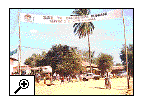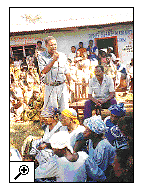|
|
 |
|
Commemoration of World Environment Day in Kigoma, Tanzania, June 1999
by B.D. Tarimo
World Environment Day (WED) is an annual event which can be celebrated in many ways, including street rallies, bicycle parades, green concerts, essay  competitions in schools, tree planting as well as recycling and clean up campaigns. WED is also a multi-media event which inspires thousands of journalists to write and report on the environment. It is a visual event with television documentaries, photo exhibits and poster displays. It is also an intellectual event for those who organize and participate in seminars, round-table meetings and symposia. All in all, WED serves to enhance public and political attention and action for the environment. competitions in schools, tree planting as well as recycling and clean up campaigns. WED is also a multi-media event which inspires thousands of journalists to write and report on the environment. It is a visual event with television documentaries, photo exhibits and poster displays. It is also an intellectual event for those who organize and participate in seminars, round-table meetings and symposia. All in all, WED serves to enhance public and political attention and action for the environment.
In this connection, Lake Tanganyika Biodiversity Project (LTBP), in collaboration with Kigoma Regional and District authorities, Government Institutions and Non-Governmental Organizations (NGOs) participated fully in commemorating this event. 
The main aims and objectives were to:
- promote environmental issues such as the benefits of nature and the great loss associated with environmental destruction, to the larger community;
- arouse public awareness of actions that promote and actions that harm the environment;
- carry out environmental management activities in collaboration with Regional and District authorities; NGOs and others.
- activate the role of informal education through such settings as role-playing during commemoration week.
| |